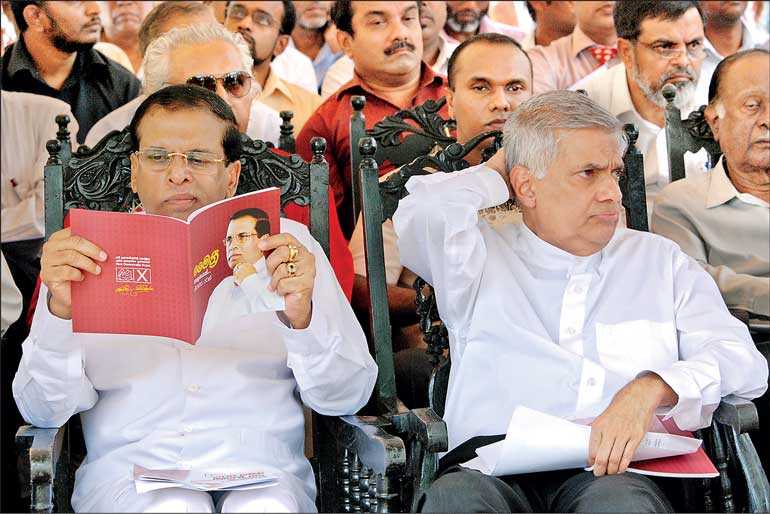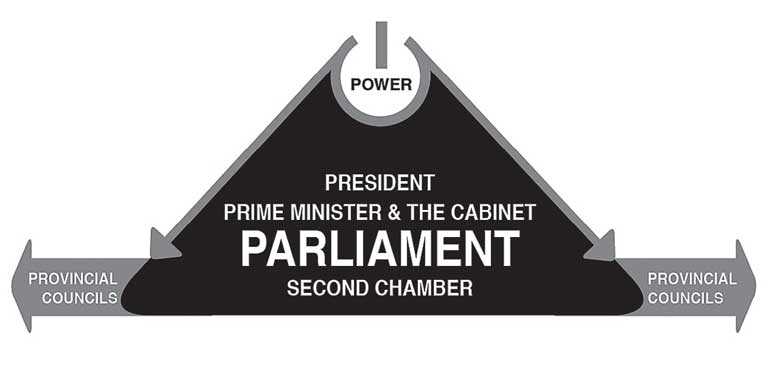Sunday Dec 15, 2024
Sunday Dec 15, 2024
Wednesday, 6 February 2019 00:00 - - {{hitsCtrl.values.hits}}

It is perceived that in the process of creating a new constitution there are two issues to be addressed. One is about the executive presidency and the other is about devolution of power as a solution to the ethnic issue. 
Those are not two issues, rather one issue. It is about delegation of power vertically downwards and horizontally from centre to the periphery. It is demonstrated in the diagram. In the proposed new constitution, it was tried in both directions and ultimately the outcome is a very democratic governance system with no one or institution is having absolute authority.
Proposed constitution
As the first step of the process the Government established the Public Representations Committee on Constitutional Reform headed by Lal Wijenayake and the report was issued in May 2016. Thereafter the Parliament met as a constitutional assembly with the powers of Parliamentary Select Committee to draft the new constitution.
There were 21 Members of the Parliament in the Steering Committee of the Constitutional Assembly which is headed by the Prime Minister. The purpose of this Committee is to prepare the draft constitutional proposals. The Steering Committee wanted further public consultations and based on those public representations, the Committee published another report in July 2016.
In May 2016 the Constitutional Assembly appointed members representing all parties in the Parliament to six sub committees covering the areas of Fundamental Rights, Judiciary, law and Order, Public Finance, Public Service and Centre-Periphery Relations to assist the Steering Committee.
All the reports of the sub committees were published. Based on the Steering Committee deliberations and reports of the sub committees, an expert panel prepared a report to the Steering Committee in the form of a draft constitution and the Steering Committee decided to present the same to the Constitutional Assembly without preparing its own draft. In the appendix of the proposed draft there are alternative proposals by the political parties as well as the certain members of the expert panel.
In the proposed constitution, Sri Lanka was identified as an aekiya rajyaya/orumiththa nadu and the word unitary was removed. M.A. Sumanthiran MP, who is a member of the Steering Committee, mentioned at a television debate that although the State is ‘aekiya’ the governance structure is having federal features so that the word unitary cannot be used to identify the Republic of Sri Lanka. The present governance structure based on the 13th Amendment to the Constitution is also having federal features.
In the present Constitution there are five ways to exercise the sovereignty of the people but in the proposed constitution it was stated as follows: “In Sri Lanka sovereignty is in the People and is inalienable, and includes the powers of government, fundamental rights and the franchise.” “The legislative, executive and judicial power of the People shall be exercised as provided for by the Constitution…”
The indication in the present Constitution that the judicial power of the people shall be exercised by Parliament through courts was removed. Also, it was stated that no Provincial Council or other authority may declare any part of the territory of Sri Lanka to be a separate State or advocate or take steps towards the secession of any Province or part thereof, from Sri Lanka. If such a thing happens, according to Section 291 the President after consulting the Prime Minister and with the supervision of the Supreme Court can dissolve or takeover that Provincial Council.
There is an alternative proposal as well for the religion. It is proposed to have the existing provision as it is and as an alternative proposal it was suggested to give Buddhism the foremost place while treating all religions and beliefs with honour and dignity. 
Fundamental rights are extended from 10th to 17th article of the present Constitution but in the proposed one it is not only civil and political rights, but also social, economic and environmental rights are included. This chapter is consisting of 39 articles from 9th to 47th. Among them livelihood, health, education, food, shelter, water, social protection, environment and child and disabled rights are included. The sub committee headed by Mahinda Samarasinghe MP, has recommended to include all these rights to the proposed constitution.
The President of the Republic shall be the Head of the State and the Commander-in-Chief of the Armed Forces. He is not the head of the Government and not appointed by the people. He is elected by the Parliament and the proposed Second Chamber. In most of the time he shall act on the advice of the Prime Minister.
Executive is comprising of the Cabinet of Ministers and Prime Minister as well. The Head of the Government is the Prime Minister. There can be 30 Cabinet Ministers and 30 Non-Cabinet Ministers. When the Cabinet of Ministers formulate National Policy on any matter contained in the Provincial List, they shall adopt a participatory process with the Provincial Boards of Ministers.
Legislature is comprising of the Parliament and the Second Chamber. There shall be 233 elected Members of Parliament. There are restrictions imposed on the discretion of the President in selecting the Prime Minister. Second chamber comprises 55 members. Each Provincial Council can appoint five members to the second chamber so that 45 members are appointed from nine Provincial Councils. Parliament should nominate 10 eminent persons who are not members either of the Parliament or of the Second Chamber.
All the Bills should be referred to the Second Chamber and the Parliament before enacting should give due consideration of the views of the Bill once it referred back to the Parliament. If the Parliament enacts laws pertaining to the powers of Provincial Councils, Parliament should get consent of all Provincial Councils. Otherwise it should get the approval from the people at a referendum in addition to getting approval of two-third of members of the Parliament or of second Chamber.
Power of Governors is curtailed, and they should act on the advice of the Chief Ministers. In addition to the Supreme Court there is a constitutional court to deal with constitutional affairs.
Political culture
Our political culture can be examined in comparison to our neighbour India. Both India and Sri Lanka have high power distance. According to Geert Hofstede, “Power distance is the extent to which the lower-ranking individuals of a society accept and expect that power is distributed unequally.”
In high power distant countries, “The power relations are paternalistic and autocratic, and there is centralised authority. In other words, there is a wide gap or emotional distance which is perceived to exist among people at different levels of the hierarchy. There is considerable dependence of people on power holders.” It can be home, school, work place or the society. These cultures would easily create autocratic leaders.
In the freedom struggle in India which was led by Mahatma Gandhi, the decisions were taken democratically. Gandhi’s proposals for all actions were not approved unanimously or with an overwhelming majority. Certain proposals were approved with narrow margins. Gandhi created a political culture that those who were opposed were not suppressed even though they had a very small number. Democracy and inclusiveness were deliberately introduced to the Indian polity by the leaders of freedom struggle.
In Sri Lanka it was quite different. During the independence struggle leaders could not keep all the ethnic and religious groups together. They also could not maintain the democratic processes to the extent India maintained the same. There is no internal democracy of the main organised political parties, i.e. UNP, SLFP and SLPP. Leaders of those parties play a major role in decision making. Those leaders cannot be removed easily so as the President of the country.
There are instances where the devolved power to the Provincial Councils were taken over by the Centre with the blessings of the Judiciary and the Parliament. In recent incident of the political coup launched on 26 October by none other than the President, he exercised power where he had no authority. If he had doubt, he could have checked with the Supreme Court. The most disturbing point was there was support for him from various sections of the citizens throughout the country, educated or otherwise.
Therefore, the Sri Lankan political culture merely reflects the social power distance whereas in India the political culture was carefully crafted during the freedom struggle and it was evolved throughout from the independence.
Constitution of India
154. (1) of the Indian Constitution is as follows: “The executive power of the State shall be vested in the Governor and shall be exercised by him either directly or through officers subordinate to him in accordance with this Constitution.”
154C of current constitution of Sri Lanka is as follows: “Executive power extending to the matters with respect to which a Provincial Council has power to make statutes shall be exercised by the Governor of the Province for which that Provincial Council is established, either directly or through Ministers of the Board of Ministers, or through officers subordinate to him, in accordance with Article 154F.”
Article 154F deals with the Board of Ministers and the Chief Minister. The Indian system worked well but the Sri Lankan system failed. The Indian Rajya Sabha is similar to the proposed second chamber where the members are elected from the States/Provincial Councils. There was a political understanding between the centre and the peripheries. During the early stages Congress party had power in the Centre and most of the States. Later when this was changed during the time of Indira Gandhi there were clashes between the Centre and the States and now they have come to an understanding.
In the sub committee report of centre-periphery relations it was mentioned that the Governors acted in arbitrary manner assuming the powers of the President who was the appointing authority. Chief Ministers of the SLFP suggested more powers to the Chief Ministers. Chief Minister of the North Central Province of SLFP suggested to abolish the post of the Governor.
Therefore, it was stated in the proposed constitution as follows: “Except where specifically provided otherwise in the Constitution, the executive power of the Province shall be exercised by the Chief Minister and the Board of Ministers.” The Governor is above the Chief Minister but it is similar to the role of the President of the proposed constitution.
The reason for this situation is that Sri Lanka does not have a matured political culture. Therefore everything has to be specifically stated in the constitution.
Article 45 of the first Constitution of Sri Lanka was as follows. “The executive power of the Island shall continue vested in Her Majesty and may be exercised, on behalf of Her Majesty, by the Governor-General in accordance with the provisions of this Order and of any other law for the time being in force.” However, the executive function was carried out by the Prime Minister and the Cabinet.
But during the time of communal riots in 1958 the Governor General took over the control since the Prime Minister was inactive for political reasons. Tarzie Vittachi reported in his book ‘Emergency 58’ as follows: “But Sir Oliver couldn’t resist making the point clear by telling us: ‘Gentlemen. One favour. One personal request. When you report the news in future please don’t say that I am running the sh-shshow. I don’t want all kinds of jealousies to come up, you know.’ That made it official. Sir Oliver was running the show.” In July 1983 an inactive President for political reasons created immense damage to the country.
All this is depending on the political culture and understanding. All the details sometimes cannot be documented in the constitution.
Conclusion
We have faced three armed struggles after independence. At present ‘Ginnen Upan Seethala’ – ‘Frozen Fire’ is being screened. Wijeweera and Prabhakaran along with their supporters did not sacrifice their lives for personal gains although their undemocratic approach cannot be approved.
As a nation we have not given due recognition for the reasons they have sacrificed their lives except the few actions taken by R. Premadasa, former President, after the defeat of JVP struggle in 1989. Those rebellions were against authoritative regimes which did not practice democracy although they preached it.

Our leaders and their followers tend to preach democracy but not to practice it. They love to exercise power whether they have authority or not. The Prime Minister and specially the President have blatantly violated the people’s aspirations bestowed upon them in 2015. None of them has given leadership to the process of making a new constitution. The drafted constitution is much similar to the Constitution of India.
The proposed constitution tried to flatten the hierarchical structure of power and at the same time distribute it to the periphery. Based on the behaviour of our leaders it is doubtful that they will promote it. It looks like that they demand another armed struggle but as responsible citizens we have to restrict the struggle to a democratic one. That is the challenge we face today.
(The writer is a Chartered Accountant and holds a MBA offered by PIM of University of Sri Jayewardenepura.)